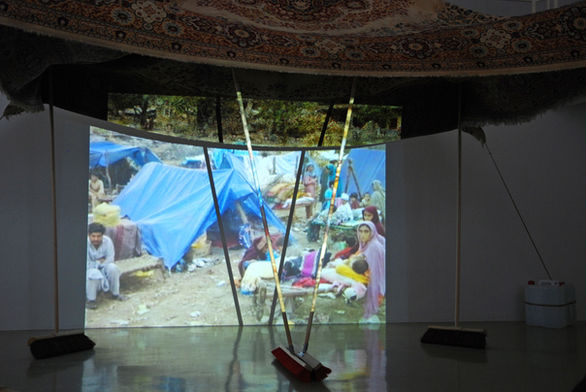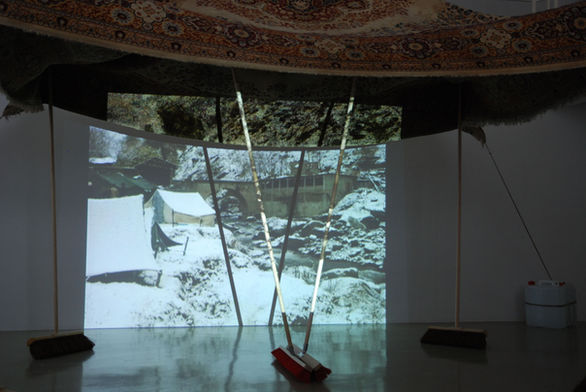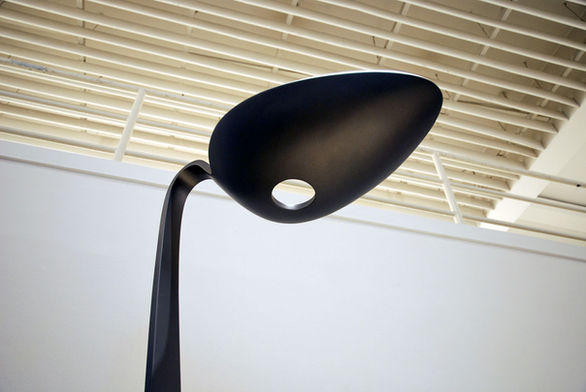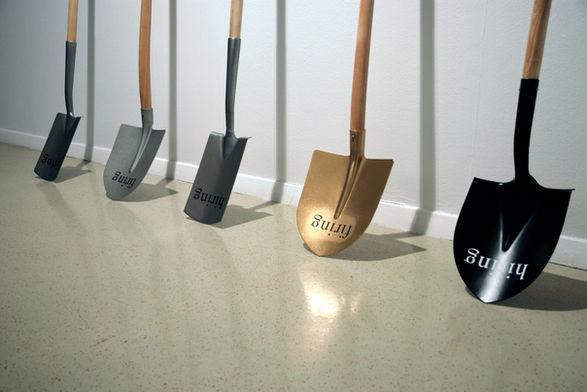exhibition venue:
Galerija Galzenica, Velica Gorica, Croatia, 2010
Tent Cities
2010
A rug suspended in the air on wooden poles 2-2,5 meters above the ground in the middle of the exhibition space creates a temporary shelter. The carpet seems to be floating except for the four corners anchored with rope to large canisters holding drinking water. Through this tent-like structure a slide show of images belonging to our collective global consciousness, culled from the internet, is projected onto the main wall of the exhibition space.
The rug is clearly Persian and the wooden poles are broom handles complete with brush heads, six in all, creating a sheltered living space under the carpet large enough for a person to walk through, stand up in, or for a family to sleep in. The projected images on the wall are events from our world today, primarily documenting the hardship of man-made catastrophes and events surrounding the aftermaths of natural disasters. Many of these instances have resulted in deaths, where the fortunate survivors have been reduced to living in tent cities, suddenly thrust into nomadic times. A significant aspect of the documented events is how one individual has profited at the expense of another.
The Tent Cities installation is augmented by several other sculptural objects - Spoon Monument, The CEO Award, and Cross Broom - whose presence further contextualize the authorship, and responsibility for the actions committed, or in some cases, lack of action (“no laws were broken", and "back to business as usual”). This installation and supporting works intend to facilitate the remembering of these events through a more complete and comprehensive imagery.
The installation is intended to stimulate a dialog based on fact rather than illusion, not to glamorize disaster and hardship, or to celebrate the morose, but simply to remind us that in times like these, all of us, with all our best intentions, could end up living in a tent made from a Persian rug and several brooms.
Spoon Monument
painted monochromed steel & fiberglass,
194 x 65 x 45 cm
Spoon Monument
2003-2010
With a bent handle forming a foot support and the head horizontally inclined, the Spoon Monument resembles an elevated receptacle, and at first appears to symbolize the trust and hope that individuals place in each other and in society. On approaching the work, a large hole can be seen in the bottom of the spoon head, making it useless and incapable of holding/spooning anything. This concealed deception translates into a monumental sculptural symbol of disillusionment, nostalgia; the perpetual longing for a better life.
The CEO Award
wood, metal, paint
194 x 200 x 30 cm
The CEO Award
2009
This edition of five double-headed shovels, unsuspectingly resembling kayak paddles, are being proposed to be awarded annually, to be dedicated to the most prolific and qualified CEO in the country/world. On each shovel head is written "hiring" (for the good times) and "firing" (for the bad times), the current mood in vogue indicated by which shovel head, with accompanying text, is pointing upward.

Cross Broom
wood, plastic
212 x 85 x 85 cm
Cross Broom
2010
Suggesting a Greek cross and the spreading of the Christian gospel, some kind of hope, in all directions - north, south, east and west - the intersecting broom-heads make a base to support the long vertical street-sweepers handle. Irony or tragedy, having lost its usefulness as a broom, as an instrument for cleaning up and creating order, this hybrid tool takes on a new architectural function, that of doubling as a stable support for holding up a roof, or in this case, just a Persian rug. Is this transformation really cause for rejoicing, or is the hope manifested by this cross broom trapped in a conflict of interests?













